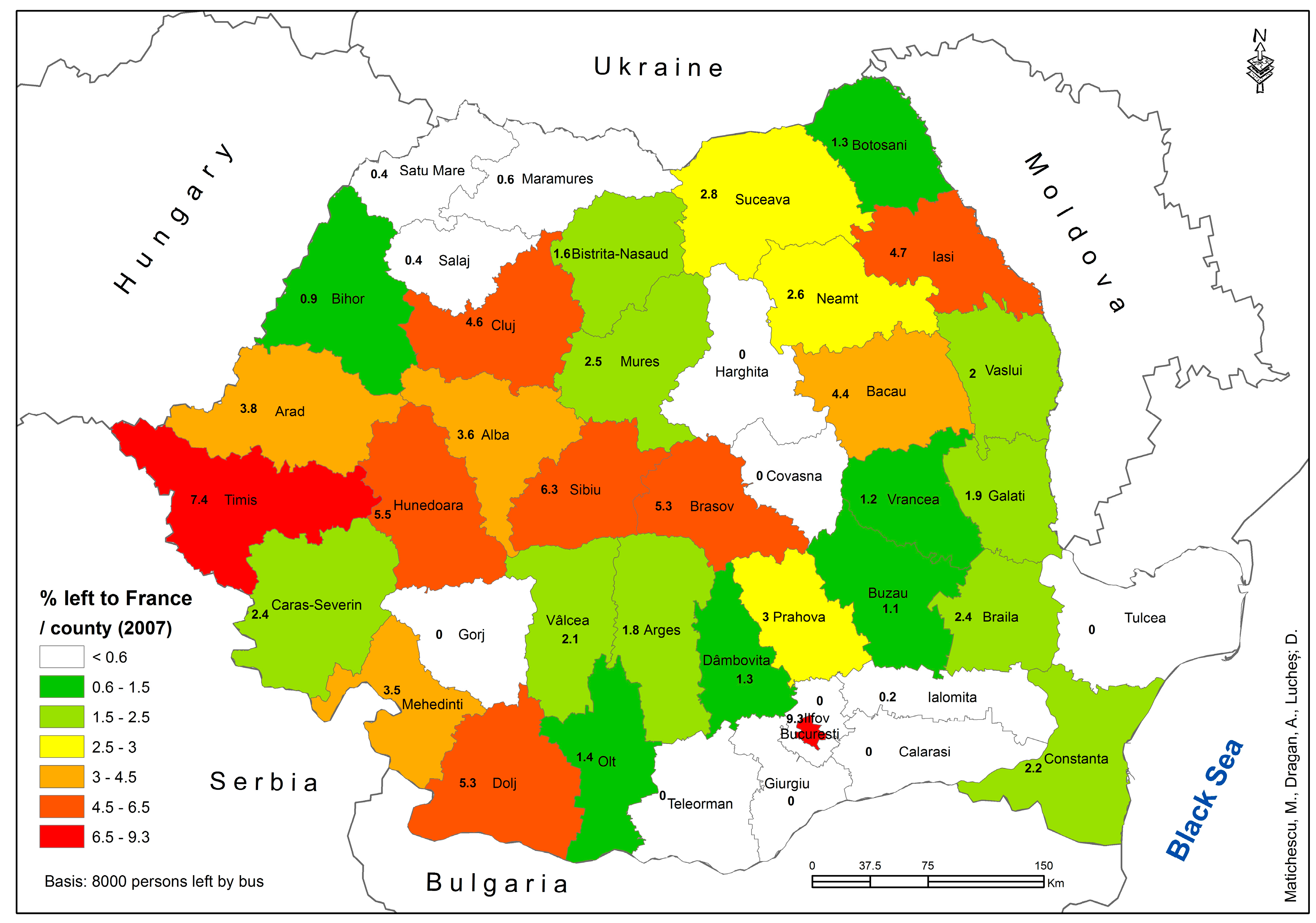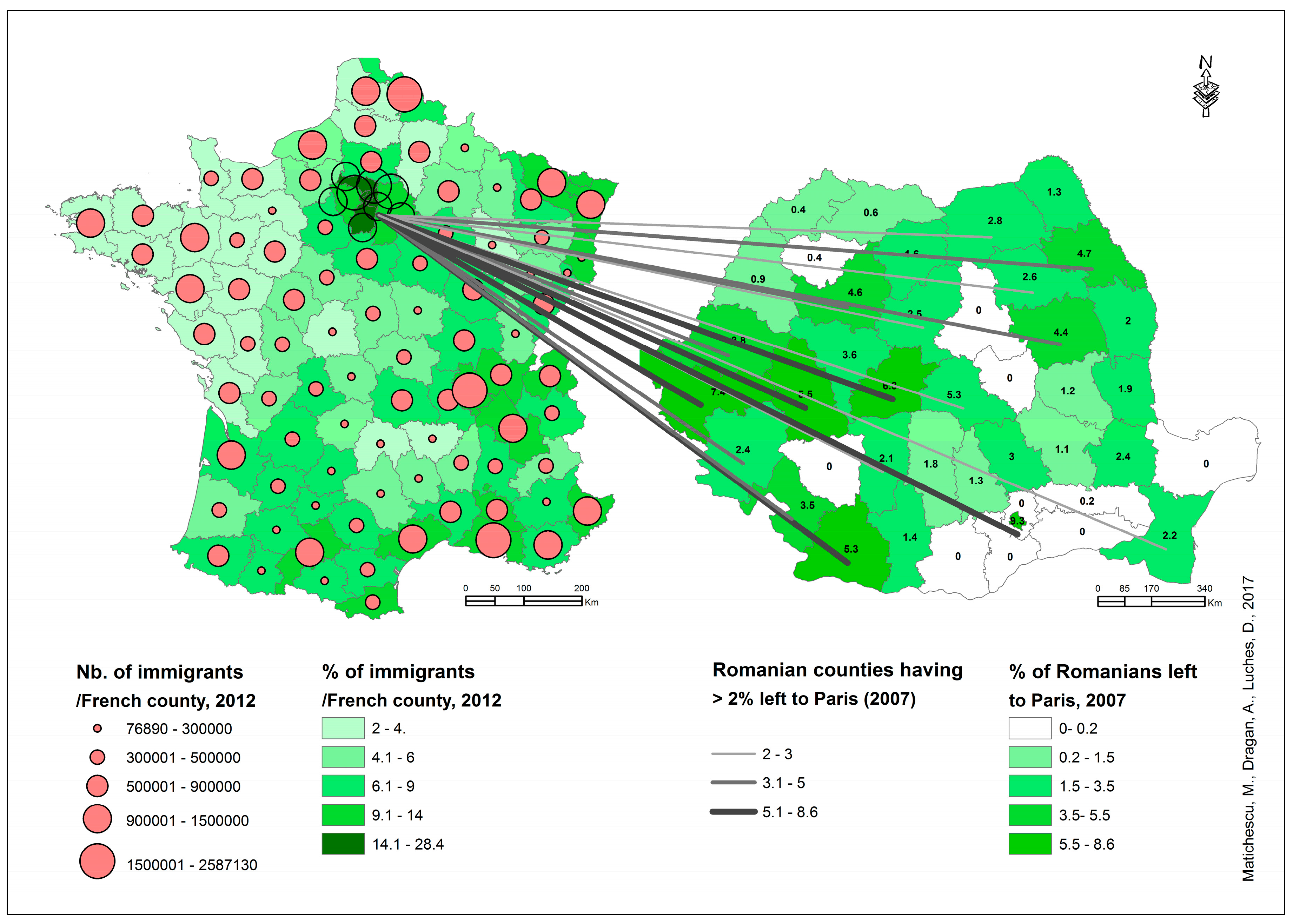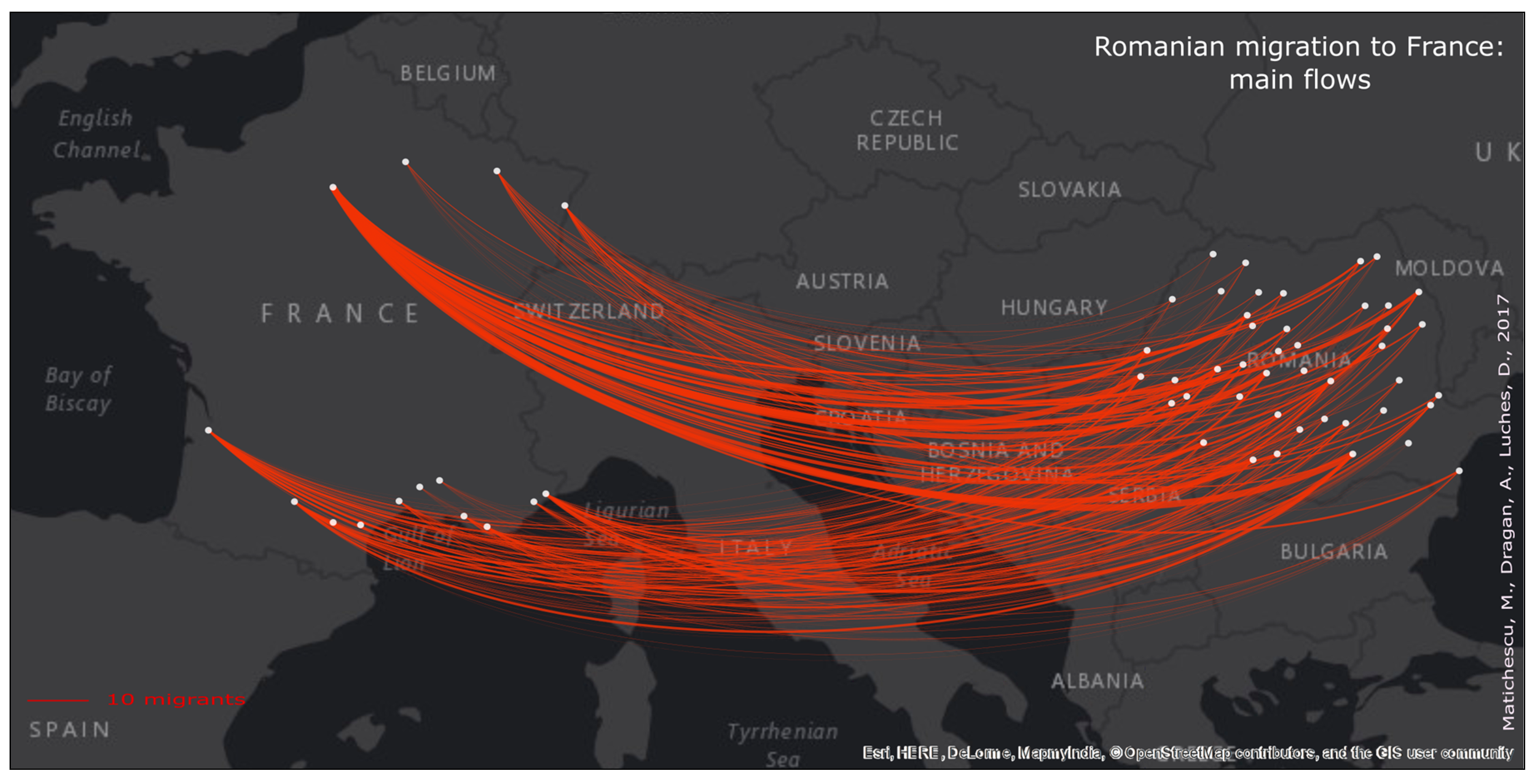Channels to West: Exploring the Migration Routes between Romania and France
Abstract
1. Introduction
2. Conceptual Basis for Analyzing the Migration Routes Existing between Romania and France
3. Methodology
3.1. Operational Definitions for Our Terms
3.2. Choosing the Data
3.3. The Population and the Samples Studied
3.4. Analysis and Interpretation of Data
3.5. Limits
4. Results
4.1. The Departure Regions of Romania
4.2. The Intensity of Emigration among the Population of the Department
- A = Emigration rate per department calculated in accordance with our calculations
- B = Population percentage of the department in relation to the total population
- C = probable emigration rate per department
- B = C
- I = intensity of the emigration flow per department
- I = A − C
- A = 7.4%
- B = 3.12%
- C = 3.12%
- I= 7.4% − 3.13% = 4.27%
4.3. Destinations Favored by the Romanians in France
4.4. The Migratory Circuit between Romania and France
5. Conclusions
Acknowledgments
Author Contributions
Conflicts of Interest
References
- Organisation for Economic Co-operation and Development. International Migration Outlook; OECD: Paris, France, 2013; ISBN 9789264200166. [Google Scholar]
- Organisation for Economic Co-operation and Development. International Migration Outlook: SOPEMI; OECD: Paris, France, 2016; ISBN 9789264258457. [Google Scholar]
- Sandu, D.; All, E. L’habitation Temporaire à L’étranger; Fondation pour une Société Ouverte: Bucuresti, Romania, 2006. [Google Scholar]
- Serban, M.; Stoica, M. Politici şi Instituţii în Migraţia Internaţională: Migraţie Pentru Muncă din România, 1990–2006; Fundatia pentru o Societate Deschisa: Bucuresti, Romania, 2007. [Google Scholar]
- Diminescu, D.; Lazaroiu, S. Circulatory Migration of Romanians; International Organization for Migration: Paris, France, 2002. [Google Scholar]
- Boswell, C.; Mueser, P.R. Introduction: Economics and Interdisciplinary Approaches in Migration Research. J. Ethn. Migr. Stud. 2008, 34, 519–529. [Google Scholar] [CrossRef]
- Massey, D.S.; Alarcon, R.; Durand, J.; Gonzalez, H. Return to Aztlan: The Social Process of International Migration from Western Mexico; University of California Press: Berkeley/Los Angeles, CA, USA, 1987. [Google Scholar]
- Boswell, C.; Ciobanu, O. Culture, utility or social systems? Explaining the cross-national ties of emigrants from Bora, Romania. Ethnic Racial Stud. 2009, 32, 1346–1364. [Google Scholar] [CrossRef]
- Saghin, D.; Luches, D. The influece of personal and professional variables upon the nature of immigration of romanan doctors to France: The moderationg effect of gender. Transylv. Rev. 2016, 49, 132–149. [Google Scholar]
- Favell, A. The new face of East—West migration in Europe. J. Ethnic Migr. Stud. 2008, 34, 701–716. [Google Scholar] [CrossRef]
- Matichescu, M.L.; Anamaria, B.I.C.A.; Ogodescu, A.S.; Lobont, O.R.; Moldovan, N.C.; Iacob, M.C.; Sorana, R.O.S.U. The Romanian Migration: Development of the Phenomenon and the Part Played by the Immigration Policies of European Countries. Rev. Cercet. Interv. Soc. 2015, 50, 225–238. [Google Scholar]
- Marcu, S. Uneven mobility experiences: Life-strategy expectations among Eastern European undergraduate students in the UK and Spain. Geoforum 2014, 58, 68–75. [Google Scholar] [CrossRef]
- Popa, N.; Luches, D. Etudier la médecine pour émiger? In Migration en Blanc. Médecins D’est en Ouest; L’Harmattan: Paris, France, 2014; pp. 83–100. [Google Scholar]
- Marcu, S. Sobrevivir a la transición: La emigración internacional de rumanos desde un enfoque territorial. Cuad. Geogr. 2008, 34, 135–152. [Google Scholar]
- De la Rica, S.; Albrecht, G.; Ortega, F. Immigration in Spain: What have we learned from recent evidence? Cuad. Econ. ICE 2014, 87, 9–29. [Google Scholar]
- Roman, M.; Andren, D. Should I Stay or Should I Go? Romanian Migrants During Transition and Enlargements. In Labor Migration, EU Enlargement, and the Great Recession; Springer: Berlin, Germany, 2016; pp. 247–271. [Google Scholar]
- Devitt, C. Labour Migration Governance in Contemporary Europe: The Case of France; Bank of Canada Working Papers; Bank of Canada: Ottawa, ON, Canada, 2012. [Google Scholar]
- Diminescu, D. Pour une anthropologie des migrations roumaines en France. Le cas du Pays d’Oas. Migr. Etud. 1999, 91, 1–19. [Google Scholar]
- National Institute of Statistics of Romania. Statistics. 2017. Available online: http://statistici.insse.ro/shop/index.jsp?page=tempo3&lang=ro&ind=POP309D (accessed on 14 February 2017).
- Faist, T. The Volume and Dynamics of International Migration and Transnational Social Spaces; Clarendon Press: Oxford, UK, 2000. [Google Scholar]
- Thomas, W.; Znanicki, F. The Polish Peasant en Europe and America; Chicago University Press: Chicago, IL, USA, 1918–1920. [Google Scholar]
- Massey, D.S.; Arango, J.; Hugo, G.; Kouaouci, A.; Pellegrino, A.; Taylor, J.E. Worlds in Motion. Understanding International Migration at the End of the Millennium; Clarendon Press: Oxford, UK, 1998. [Google Scholar]
- Arango, J. Explaining migration: A critical view. In UNESCO 2000; Blackwell Publishers: Oxford, UK, 2000. [Google Scholar]
- Dragan, A.; Popa, N. Social Economy in Post-communist Romania: What Kind of Volunteering for What Type of NGOs? J. Balk. Near East. Stud. 2017, 19, 330–350. [Google Scholar] [CrossRef]
- Manski, C. Economic analysis of social interactions. J. Econ. Perspect. 2000, 14, 115–136. [Google Scholar] [CrossRef]
- Kritz, M.; Lim, L.L.; Zlotnik, H. International Migration Systems: A Global Approach; Clarendon Press: Oxford, UK, 1992. [Google Scholar]
- Sandu, D. Romanian Migration as Multiregional Building of Transnational Fields. Romanians’ Social Transnationalism in the Making. 2014. Available online: http://www.ssoar.info/ssoar/handle/document/39528 (accessed on 14 February 2017).
- Collyer, M.; King, R. Producing transnational space: International migration and the extra-territorial reach of state power. Prog. Hum. Geogr. 2014, 39, 185–204. [Google Scholar] [CrossRef]
- Pott, A. Geography of migration. In The Encyclopedia of Global Human Migration; Blackwell Publishing: Oxford, UK, 2013; pp. 12–20. [Google Scholar]
- Marcu, S. Romanian Migration to the Community of Madrid (Spain): Patterns of Mobility and Return. Int. J. Popul. Res. 2011, 2011, 1–13. [Google Scholar] [CrossRef]
- Glaeser, E. The new economics of urban and regional growth. In The Oxford Handbook of Economic Geography; Oxford University Press: Oxford, UK, 2000; pp. 83–98. [Google Scholar]
- Boschma, R.; Eriksson, R.; Lindren, U. How does labour mobility affect the performance of plants? The importance of relatedness and geographical proximity. J. Econ. Geogr. 2009, 9, 169–190. [Google Scholar] [CrossRef]
- Hudson, R. Economic Geographies: Circuits, Flows and Spaces; Sage: Newcastle upon Tyne, UK, 2005; p. 248. [Google Scholar]
- Basant, R. Knowledge Flows and Industrial Clusters: An Analytical Review of Literature; East-West Center: Honolulu, HI, USA, 2002. [Google Scholar]
- Faist, T. The Crucial Meso-Level. In International Migration Immobility and Development; Berg: Oxford, UK, 1997. [Google Scholar]
- Anghel, R.G. Changing Statuses: Freedom of Movement, Locality and Transnationality of Irregular Romanian Migrants in Milan. J. Ethnic Migr. Stud. 2008, 34, 787–802. [Google Scholar] [CrossRef]
- Elrick, T.; Ciobanu, O.R. Migration networks and policy impacts: Insights from Romanian-Spanish migrations. Glob. Netw. 2009, 9, 100–116. [Google Scholar] [CrossRef]
- Marcu, S. From the Marginal Immigrant to the Mobile Citizen: Reconstruction of Identity of Romanian Migrants in Spain. Popul. Space Place 2015, 21, 506–517. [Google Scholar] [CrossRef]
- Nedelcu, M. Migrants’ New Transnational Habitus: Rethinking Migration Through a Cosmopolitan Lens in the Digital Age. J. Ethnic Migr. Stud. 2012, 38, 1339–1356. [Google Scholar] [CrossRef]
- Martin, O. Les Enquête et ses Méthodes: L’analyse de Données Qunatitatives; Armand Colin: Paris, France, 2007. [Google Scholar]
- Rey, V.; Diminescu, D.; Ohlinger, R. Les Circulations Migratoires Roumaines: Une Intégration par la Bas? Edition de la Maison des Siences de l’Homme: Paris, France, 2001. [Google Scholar]
- Lazaroiu, S. More ‘Out’ than ‘In’ at the Crossroads between Europe and the Balkan; International Organization for Migration: Bucharest, Romania, 2003. [Google Scholar]
- Fundația pentru o Societate Deschisă. Living Abroad on a Temporary Basis the Economic Migration of Romanians: 1990–2006; Fundația pentru o societate deschisă: Bucharest, Romania, 2006. [Google Scholar]
- Sandu, D. Cum “ajungi” intr-un sat sarac: Drumul Sociologic. Sociol. Românească 2001, 1–4, 153–171. [Google Scholar]
- World Bank. Magnet cities: Migration and commuting in Romania; World Bank: Bucharest, Romania, 2017. [Google Scholar]
- Durkheim, É. Le Suicide; Presses Universitaires de France: Paris, France, 1990. [Google Scholar]
- Potot, S. La place des femmes dans les réseaux migrants roumains. Revue Eur. Migr. Int. 2005, 21, 243–257. [Google Scholar] [CrossRef]



| Regions | Migration Frequency (No.) | Migration Percentage (A) | Population Number | Population Percentage (BetC) | Intensity Migratory Phen. (I) |
|---|---|---|---|---|---|
| Bihor | 74 | 0.9 | 600,223 | 2.77 | −1.87 |
| Satu Mare | 33 | 0.4 | 369,096 | 1.70 | −1.30 |
| Maramures | 89 | 1.1 | 510,688 | 2.35 | −1.25 |
| Arges | 142 | 1.8 | 653,903 | 3.01 | −1.21 |
| Dambovita | 105 | 1.3 | 541,326 | 2.49 | −1.19 |
| Buzau | 87 | 1.1 | 494,982 | 2.28 | −1.18 |
| Ialomita | 16 | 0.2 | 296,486 | 1.37 | −1.17 |
| Constanta | 176 | 2.2 | 715,172 | 3.30 | −1.10 |
| Galati | 151 | 1.9 | 619,522 | 2.86 | −0.96 |
| Bucharest | 753 | 9.3 | 2,221,860 | 10.24 | −0.94 |
| Olt | 112 | 1.4 | 490,276 | 2.26 | −0.86 |
| Prahova | 243 | 3 | 829,224 | 3.82 | −0.82 |
| Botosani | 108 | 1.3 | 454,023 | 2.09 | −0.79 |
| Salaj | 31 | 0.4 | 248,407 | 1.14 | −0.74 |
| Vrancea | 98 | 1.2 | 390,268 | 1.80 | −0.60 |
| Suceava | 224 | 2.8 | 690,941 | 3.18 | −0.38 |
| Vaslui | 160 | 2 | 455,550 | 2.10 | −0.10 |
| Mures | 208 | 2.6 | 579,862 | 2.67 | −0.07 |
| Neamt | 209 | 2.6 | 557,084 | 2.57 | 0.03 |
| Bistrita Nasaud | 129 | 1.6 | 312,325 | 1.44 | 0.16 |
| Valcea | 174 | 2.1 | 413,570 | 1.91 | 0.19 |
| Braila | 198 | 2.4 | 373,897 | 1.72 | 0.68 |
| Caras-Severin | 198 | 2.4 | 333,396 | 1.54 | 0.86 |
| Iasi | 383 | 4.7 | 819,044 | 3.77 | 0.93 |
| Bacau | 352 | 4.3 | 708,751 | 3.27 | 1.03 |
| Cluj | 352 | 4.3 | 703,269 | 3.24 | 1.06 |
| Arad | 309 | 3.8 | 461,730 | 2.13 | 1.67 |
| Alba | 292 | 3.6 | 382,999 | 1.77 | 1.83 |
| Dolj | 432 | 5.3 | 734,823 | 3.39 | 1.91 |
| Mehedinti | 285 | 3.5 | 306,118 | 1.41 | 2.09 |
| Brasov | 423 | 5.2 | 588,366 | 2.71 | 2.49 |
| Hunedoara | 439 | 5.4 | 487,115 | 2.24 | 3.16 |
| Timis | 598 | 7.4 | 677,744 | 3.12 | 4.28 |
| Sibiu | 511 | 6.3 | 422,224 | 1.95 | 4.35 |
| Average | 238.0588 | 2.935294118 | 0.30 | ||
| Standard Deviation | 170.8066 | 2.102795016 | 1.63 |
| Arrival City | Frequency (No.) | Percentage (%) |
|---|---|---|
| Narbonne | 45 | 0.56 |
| Carcassonne | 46 | 0.57 |
| Nîmes | 51 | 0.63 |
| Avignon | 80 | 0.99 |
| Reims | 95 | 1.17 |
| Cannes | 221 | 2.73 |
| Montpellier | 233 | 2.88 |
| Toulon | 258 | 3.19 |
| Marseille | 321 | 3.97 |
| Metz | 343 | 4.24 |
| Strasbourg | 473 | 5.84 |
| Toulouse | 707 | 8.73 |
| Nice | 902 | 11.14 |
| Bordeaux | 920 | 11.37 |
| Paris | 3399 | 41.99 |
| Total | 8094 | 100 |
| Average | 539.6 | 6.67 |
© 2017 by the authors. Licensee MDPI, Basel, Switzerland. This article is an open access article distributed under the terms and conditions of the Creative Commons Attribution (CC BY) license (http://creativecommons.org/licenses/by/4.0/).
Share and Cite
Matichescu, M.L.; Dragan, A.; Lucheș, D. Channels to West: Exploring the Migration Routes between Romania and France. Sustainability 2017, 9, 1861. https://doi.org/10.3390/su9101861
Matichescu ML, Dragan A, Lucheș D. Channels to West: Exploring the Migration Routes between Romania and France. Sustainability. 2017; 9(10):1861. https://doi.org/10.3390/su9101861
Chicago/Turabian StyleMatichescu, Marius Lupșa, Alexandru Dragan, and Daniel Lucheș. 2017. "Channels to West: Exploring the Migration Routes between Romania and France" Sustainability 9, no. 10: 1861. https://doi.org/10.3390/su9101861
APA StyleMatichescu, M. L., Dragan, A., & Lucheș, D. (2017). Channels to West: Exploring the Migration Routes between Romania and France. Sustainability, 9(10), 1861. https://doi.org/10.3390/su9101861





